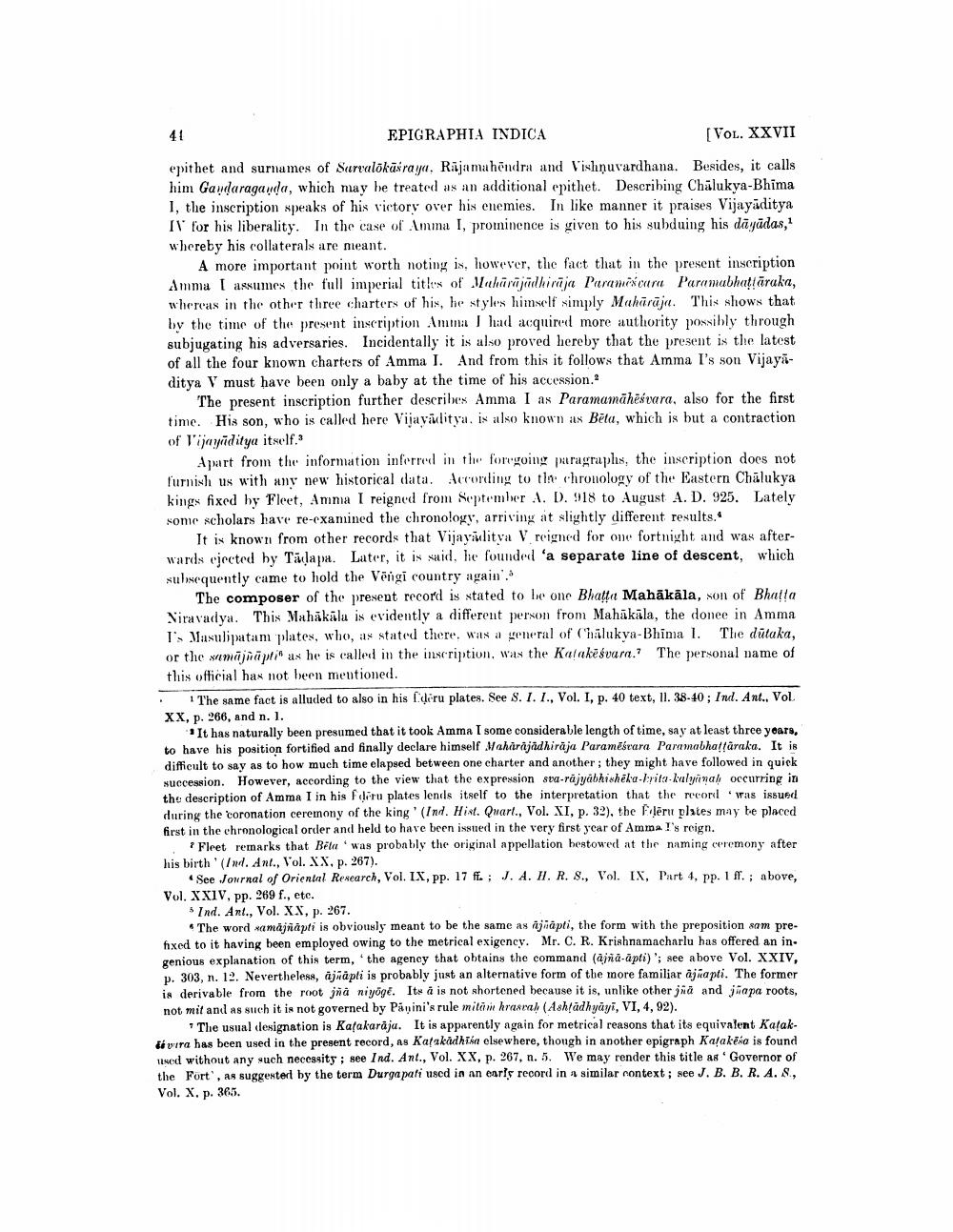________________
EPIGRAPHIA INDICA
[Vol. XXVII
epithet and surnames of Sarvalokās raya. Rijamahendra and Vishnuvardhana. Besides, it calls him Gawdaragawda, which may be treated as an additional epithet. Describing Chalukya-Bhima 1, the inscription speaks of his victory over his enemies. In like manner it praises Vijayāditya IV for his liberality. In the case of Amma I, prominence is given to his subduing his dāyādas, whereby his collaterals are meant.
A more important point worth noting is, however, the fact that in the present inscription Amma I assumes the full imperial titles of Maharjüdhirja Paramecart Paramubhattāraka, whereas in the other three charters of his, he styles himself simply Mahürūju. This shown that by the time of the present inscription Amma had acquired more authority possibly through subjugating his adversaries. Incidentally it is also proved hereby that the present is the latest of all the four known charters of Amma I. And from this it follows that Amma I's son Vijayāditya V must have been only a baby at the time of his accession.
The present inscription further describes Amma I as Paramamāheśvara, also for the first time. His son, who is called here Vijaviditya. is also known as Bēta, which is but a contraction of 'jayiditya itself.
Apart from the information inferred in the foregoing paragraphs, the inscription does not furnish us with any new historical data. According to the chronology of the Eastern Chalukya kings fixed by Fleet, Amma I reigned from September 4. D. 918 to August A. D. 925. Lately some scholars have re-examined the chronology, arriving at slightly different results.
It is known from other records that Vijayāditya V reigned for one fortnight and was afterwards cjected by Tailapa. Later, it is said, he founded a separate line of descent, which subsequently came to hold the Vengi country again.
The composer of the present record is stated to be one Bhatta Mahäkäla, son of Bhatta Niravadya. This Mahākāla is evidently a different person from Mahākāla, the donee in Amma I'Masulipatam plates, who, as stated there. Was a general of (halukva-Bhima I. The dūtaka, or the manapin as he is called in the inscription, was the Kalakesvara.? The personal name of this official has not been mentioned. • The same fact is alluded to also in his (diru plates. See 8. 1. 1., Vol. I, p. 40 text, 11. 38-40; Ind. Ant., Vol. XX, p. 266, and n. 1.
It has naturally been presumed that it took Amma I some considerable length of time, say at least three years, to have his position fortified and finally declare himself Maharajadhiraja Paramēśrara Parmabhalaraka. It is difficult to say as to how much time elapsed between one charter and another; they might have followed in quick succession. However, according to the view that the expression sva-rajyabhisheka-Brita Kulinah occurring in the description of Amma I in his feliru plates lends itself to the interpretation that the record was issued during the coronation ceremony of the king '(Ind. Hist. Quart., Vol. XI, p. 32), the Filēru plates may be placed first in the chronological order and held to have been issued in the very first year of Amma !'s reign.
Fleet remarks that Beta was probably the original appellation bestowed at the naming ceremony after his birth '(Ind. Ant., Vol. XX, p. 267).
See Journal of Oriental Research, Vol. IX, pp. 17 ff.; J. A. H. R. 8., Vol. IX, Part 4, pp. 1 ff.; above, Vol. XXIV, pp. 269 f., etc.
Ind. Ant., Vol. XX, p. 267.
The word samajnapli is obviously meant to be the same as ijiapti, the form with the preposition sam prefixed to it having been employed owing to the metrical exigency. Mr. C. R. Krishnamacharlu has offered an ingenious explanation of this term, the agency that obtains the command (ana-āpti) '; see above Vol. XXIV, p. 303, n. 12. Nevertheless, ajñāpti is probably just an alternative form of the more familiar ajñapti. The former is derivable from the root jña niyoge. Its à is not shortened because it is, unlike other jña and jaapa roots, not mit and as such it is not governed by Páyini's rule mitani hrasuah (Ash/ådhyāyi, VI, 4, 92).
The usual designation is Katakarāja. It is apparently again for metrical reasons that its equivalent Katakvira has been used in the present record, as Karakadhisa elsewhere, though in another epigraph Kalakēka is found used without any such necessity; see Ind. Ant., Vol. XX, p. 267, n. 5. We may render this title as 'Governor of the Fort'. As suggestert by the term Durgapali used in an earls record in a similar context; nee J. B. B. R. A.S, Vol. X. p. 365.




